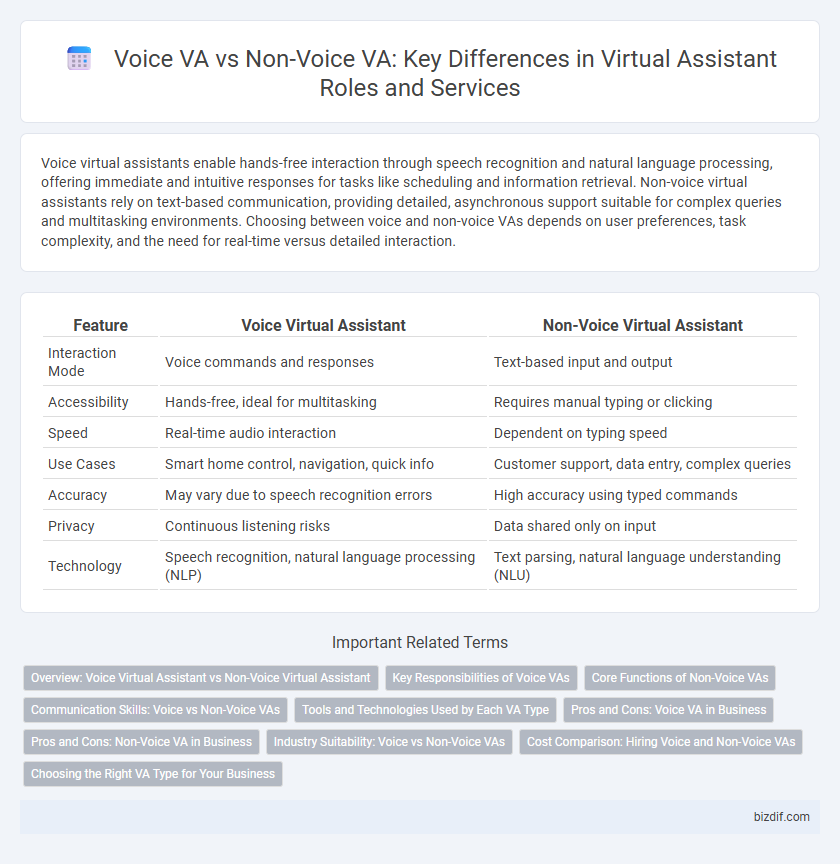Voice virtual assistants enable hands-free interaction through speech recognition and natural language processing, offering immediate and intuitive responses for tasks like scheduling and information retrieval. Non-voice virtual assistants rely on text-based communication, providing detailed, asynchronous support suitable for complex queries and multitasking environments. Choosing between voice and non-voice VAs depends on user preferences, task complexity, and the need for real-time versus detailed interaction.
Table of Comparison
| Feature | Voice Virtual Assistant | Non-Voice Virtual Assistant |
|---|---|---|
| Interaction Mode | Voice commands and responses | Text-based input and output |
| Accessibility | Hands-free, ideal for multitasking | Requires manual typing or clicking |
| Speed | Real-time audio interaction | Dependent on typing speed |
| Use Cases | Smart home control, navigation, quick info | Customer support, data entry, complex queries |
| Accuracy | May vary due to speech recognition errors | High accuracy using typed commands |
| Privacy | Continuous listening risks | Data shared only on input |
| Technology | Speech recognition, natural language processing (NLP) | Text parsing, natural language understanding (NLU) |
Overview: Voice Virtual Assistant vs Non-Voice Virtual Assistant
Voice Virtual Assistants leverage natural language processing and speech recognition technologies to facilitate hands-free, real-time interaction, enhancing user convenience and accessibility. Non-voice Virtual Assistants rely on text-based interfaces, such as chatbots or email automation, optimizing tasks like customer support and data retrieval through typed commands or scripted responses. Both types aim to improve productivity and user experience but differ fundamentally in communication modes and application contexts.
Key Responsibilities of Voice VAs
Voice Virtual Assistants specialize in managing voice communications, handling tasks such as answering calls, scheduling appointments through verbal interaction, and providing real-time customer support via voice commands. These VAs utilize speech recognition technologies to execute instructions, manage voice messages, and conduct telephonic follow-ups, ensuring efficient and personalized client engagement. Their key responsibilities also include voice-based data entry, transcription services, and facilitating hands-free navigation of digital tools for clients.
Core Functions of Non-Voice VAs
Non-voice virtual assistants excel in tasks such as managing emails, scheduling appointments, and data entry, leveraging text-based interactions to enhance productivity. They specialize in handling detailed administrative work, customer support via chat, and processing information without the need for voice commands. This allows seamless multitasking in environments where silent communication is essential.
Communication Skills: Voice vs Non-Voice VAs
Voice virtual assistants excel in verbal communication, offering natural language understanding and real-time conversational interaction, which enhances customer engagement and satisfaction. Non-voice VAs rely on written communication skills, such as email and chat support, emphasizing clarity, accuracy, and quick text-based responses to address user queries effectively. Both types of virtual assistants require specialized communication skills tailored to their interaction mode, ensuring efficient and personalized user experiences.
Tools and Technologies Used by Each VA Type
Voice virtual assistants primarily rely on automatic speech recognition (ASR), natural language processing (NLP), and text-to-speech (TTS) technologies to convert spoken commands into actionable tasks and respond verbally. Non-voice virtual assistants use advanced machine learning algorithms, chatbots, and text-based interfaces such as messaging platforms or email to process and manage user inputs without speech interaction. Both types often integrate with cloud computing services, API frameworks, and AI-driven data analytics to enhance functionality and user experience.
Pros and Cons: Voice VA in Business
Voice virtual assistants (Voice VAs) enhance business efficiency through hands-free interaction, enabling multitasking and faster response times, ideal for customer service and real-time information retrieval. However, they may struggle with understanding diverse accents or noisy environments, potentially leading to misinterpretations and reduced accuracy compared to non-voice VAs. Non-voice VAs offer precise data entry and complex task management without audio limitations but lack the immediacy and intuitive interface that voice commands provide for dynamic business settings.
Pros and Cons: Non-Voice VA in Business
Non-voice virtual assistants excel in handling complex data entry, email management, and text-based customer support, improving productivity through clear documentation and multitasking capabilities. These assistants reduce errors by utilizing automated text processing and are accessible in noisy environments where voice recognition systems struggle. However, the lack of immediate verbal interaction can limit real-time customer engagement and delay problem resolution, impacting businesses that require instant communication.
Industry Suitability: Voice vs Non-Voice VAs
Voice virtual assistants excel in sectors requiring real-time, hands-free interaction such as healthcare, customer support, and automotive industries, enabling efficient communication and task automation. Non-voice virtual assistants perform optimally in data-driven environments like finance, IT services, and content management where typing-based interactions and complex data handling are critical. Selecting between voice and non-voice VAs depends on the industry's workflow requirements, user interaction preferences, and the nature of tasks to maximize operational efficiency.
Cost Comparison: Hiring Voice and Non-Voice VAs
Hiring voice virtual assistants typically incurs higher costs due to the need for specialized equipment, clear communication skills, and voice training, averaging $15 to $30 per hour. Non-voice virtual assistants, handling tasks like data entry, email management, and research, often cost less, ranging from $8 to $20 per hour. Businesses must weigh these cost differences against task requirements to optimize operational budgets effectively.
Choosing the Right VA Type for Your Business
Selecting the right virtual assistant type significantly impacts business efficiency and cost-effectiveness. Voice VAs excel in real-time customer interaction and quick problem resolution, while non-voice VAs specialize in data management, content creation, and administrative support. Evaluating your business needs, such as customer engagement intensity and task complexity, helps determine whether a Voice VA or Non-voice VA aligns better with your operational goals.
Voice VA vs Non-voice VA Infographic

 bizdif.com
bizdif.com